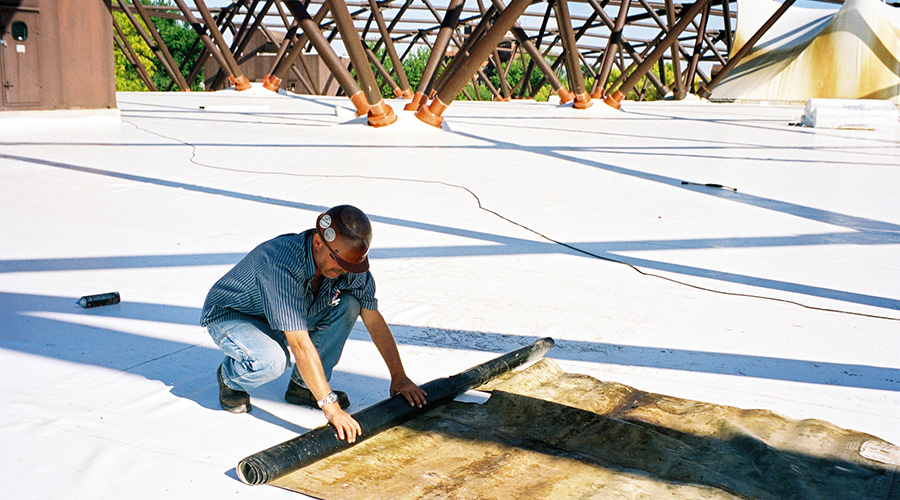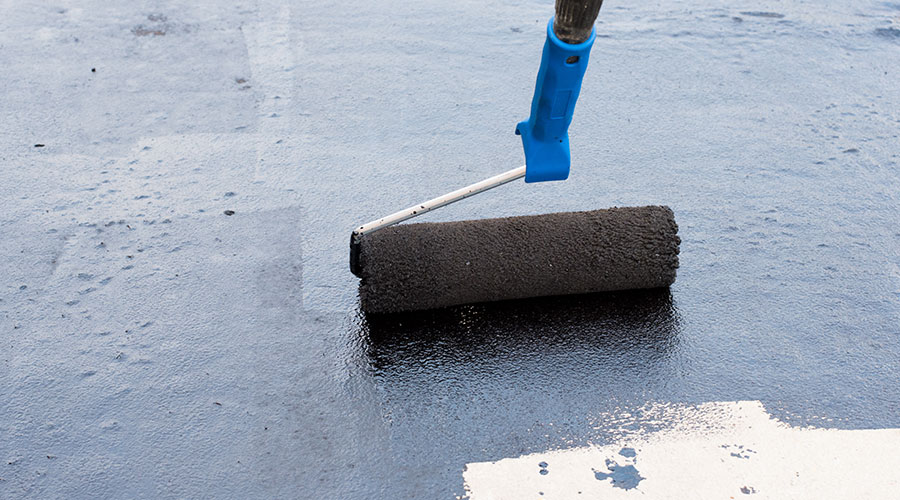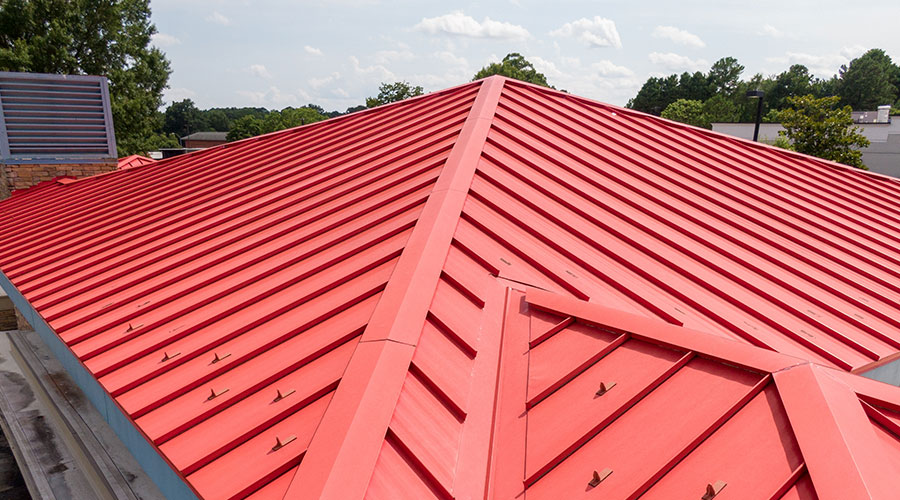Roof Coatings: Strategies for Savings
Properly specified and applied, coatings can hold down facilities’ energy use
Managers commonly specify roof coatings to extend or maximize roof life. This benefit by itself normally can be sufficient for a manager to justify installing or reapplying a coating. But reflective coatings can save organizations additional dollars by minimizing a building’s solar gain and, therefore, its cooling load.
Given this additional potential benefit, it is worthwhile for maintenance managers to investigate specifying reflective coatings to achieve energy savings. To succeed, however, the process needs to include a of review the ways manufacturers have modified coatings to meet current energy-savings programs, as well as steps managers can take to maximize a coating’s performance.
Identifying Opportunities
Depending on a building’s size, location, amount of thermal insulation, and energy costs, a reflective coating can provide energy savings by reducing a building’s cooling loads. While each building obviously is different, a typical building located in a southern climate with large enough roof area and minimal amounts of insulation will generate energy savings. In many cases, these savings can be sufficient to pay back the coating installation cost in five to seven years.
Before starting a coatings program to save energy, managers will need to analyze energy use for the specific building and coating system. Most roof consultants, architects, engineers, and utility companies can perform these audits. Coating manufacturers also can perform the audits, but managers must be aware that manufacturers might not always reflect an unbiased comparison between coating materials and savings anticipated.
Weighing the Options
Managers can specify two basic types of coatings — bituminous-based products and elastomeric-based products. Years ago, this choice was easier.
Bituminous coatings worked well on bituminous-based roofing materials, such as those in built-up and modified-bitumen systems. Elastomeric coatings worked well on single-ply membranes and spray-applied polyurethane foam. Both types of coatings worked well on metal roofs.
Today, while the choice is more complicated, managers regularly and successfully cross this product-use line.
Managers now have access to many types of bituminous coatings. Most of them are emulsions, aluminum, asphalt cutbacks, or modified-asphalt-based materials.
Bituminous coatings generally are manufactured to be compatible with asphalt or coal-tar built-up roofing systems or modified-bitumen membranes. Some manufacturers market bituminous coatings for restoring metal roofs.
Elastomeric coatings seem to encompass an even wider variety of base materials than bituminous coatings. Base materials include latex, acrylic, Hypalon, neoprene, silicone, urethane, and hybrid materials.
Manufacturers regularly introduce new types of coatings. Elastomeric coatings are compatible with most types of roofing systems, but managers use them most often on single-ply systems, spray-applied polyurethane foam, and metal roofs. Managers also can specify elastomeric coatings for use on most built-up and modified-bitumen systems.
Matching Coatings and Needs
Selecting the appropriate coating product requires research into available products offered in the area, their advantages and disadvantages, potential energy savings, and, most importantly, their compatibility with the roofing system to be coated. Nothing is more discouraging than watching a coating — and energy savings — flake off after a few short months because the coating was not compatible with the roof.
What makes a good coating? After a manager has reviewed the literature and listened to a manufacturer’s sales representatives, it is time to get down to the important elements — reflectivity and performance. All of the laboratory testing in the world cannot reproduce conditions present on the roof. Managers serious about selecting a coating product need to inspect some roofs in the area.
First, look at roofs recently coated to check a coating’s reflectivity, adhesion and appearance when it is new. Next, look at roofs that have reached or are nearing the end of the manufacturer’s anticipated life to confirm the product’s long-term performance. Finally, look at roofs nearing their half-lives to see whether the coatings have retained their reflectivity.
This process takes time, but an investment in maximizing roof life and saving energy is worth some time. The important things to look for when considering a coating include adhesion to a similar roof system, maintained reflectivity, and an ability to withstand anticipated events on the rooftop.
Adhesion is paramount. Coatings that do not adhere to the roof will not perform. Reflectivity is the method by which the coating provides energy savings. If the reflectivity fades, so goes the energy savings. The ability to withstand anticipated events is important to coating longevity. For example, if a roof ponds water, the coating must withstand ponding water.
If a coating manufacturer does not have any projects in the area, ask why. Is the coating material not compatible with the environment? Is the product new? Reputable coating manufacturers might be willing to install test patches of coating to determine if it is appropriate for the application.
Extending Life
Once the appropriate roof coating is selected, managers should take a series of important steps to maximize the coating’s performance and longevity.
First, have the coating installed by a qualified applicator following the manufacturer’s printed instructions.
Second, make sure the roof surface is clean. A coating cannot stick to a dirty roof any better than paint can stick to a dirty wall. If properly used, primers will significantly enhance the adhesion of most coatings.
Third, install the coating at the correct application rate. Too little or too much coating is not good.
Finally, make sure the coating is applied during appropriate environmental conditions. Some coatings have very specific installation temperature criteria, and some coatings cannot be installed during damp or wet weather.
Managers can obtain all of these installation criteria from the coating manufacturer and incorporate them into the installation specifications.
Coatings are maintenance items that need to be reapplied periodically. Depending on the coating type, roof system, roof drainage and environmental conditions, coatings might require replacement on a five-to seven-year cycle.
A coating might last slightly longer than this, but from a reflectivity and energy-saving standpoint, it might require replacement during this time. Managers should remember that ENERGY STAR® materials are allowed to lose about 15 percent of their reflectivity in only three years.
Compliance Issues
One final thing managers need consider in selecting a roof coating is compliance with regulations governing volatile organic compounds (VOC). Most coatings are manufactured with solvents. Depending on the building’s location and the applicable VOC regulations, a VOC-compliant coating might be required.
Even if regulations do not require a low-VOC coating, however, it might be desirable to select one as a way to reduce, though not necessarily eliminate, odors during coating application.
As energy costs rise, more managers will look to coatings as one way to decrease cooling loads and reduce energy costs. Proven performance is the key to a good coating, and the only way to truly verify performance is to visit similar local projects.
Coating manufacturers whose products comply with the provisions of the Energy Star program are good starting points in selecting a coating that can reduce peak cooling demand by 10-15 percent.
Curtis L. Liscum, RRC — curt@benchmark-inc.com — is a Registered Roof Consultant and senior consultant with Benchmark Inc. — (319) 393-9100 — a nationwide roof and pavement consulting firm based in Cedar Rapids, Iowa. He has more 20 years of experience as a roof consultant.
Reaching for the (Energy) Star
To help maintenance managers determine whether a roof coating can provide energy savings, the U.S. Environmental Protection Agency (EPA) and the U.S. Department of Energy (DOE) and several partner manufacturers developed the Energy Star® program.
Through voluntary testing by the manufacturer, a coating can be certified as compliant with the program. Compliance for commercial, low-slope roofing products entails the following:
-
an initial solar reflectance of 0.65
-
the ability to maintain a solar reflectance greater than or equal to 0.50, three years after installation under normal conditions
-
thermal emittance equal to or greater than 0.75
-
compliance with manufacturer’s standard warranty for performance.
Under Energy Star®‚ compliant products must meet the manufacturer’s standard product-performance warranty. A manufacturer cannot provide a warranty for non-compliant material that is different than that for compliant material.
Hopefully, this means manufacturers have not created special coatings simply to comply with Energy Star®.
The only rewards for using Energy Star®-compliant materials are the benefits to the environment and projected energy savings. But projected energy savings alone can be sufficient to justify applying a coating.
Some utility companies have offered rebates for installing energy-saving roofing systems that reduce energy loads, specifically during peak-demand times. If a roof area is substantially large or the savings dramatic, managers should consider contacting their local energy company to determine interest in the coating program.
Managers can identify Energy Star®-compliant products through advertisements and product labels that note their compliance. More information about the program and its partner manufacturers is available from its web site, www.energystar.gov.
— Curtis L. Liscum
|
Related Topics:











